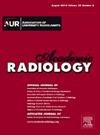A Prospective Evaluation of Chemokine Receptor-4 (CXCR4) Overexpression in High-grade Glioma Using 68Ga-Pentixafor (Pars-Cixafor™) PET/CT Imaging
IF 3.8
2区 医学
Q1 RADIOLOGY, NUCLEAR MEDICINE & MEDICAL IMAGING
引用次数: 0
Abstract
Background
While magnetic resonance imaging (MRI) remains the gold standard for morphological imaging, its ability to differentiate between tumor tissue and treatment-induced changes on the cellular level is insufficient. Notably, glioma cells, particularly glioblastoma multiforme (GBM), demonstrate overexpression of chemokine receptor-4 (CXCR4). This study aims to evaluate the feasibility of non-invasive 68Ga-Cixafor™ PET/CT as a tool to improve diagnostic accuracy in patients with high-grade glioma.
Methods
In this retrospective analysis, a database of histopathology-confirmed glioma patients with MRI findings consistent with high-grade gliomas was utilized. Within 2 weeks of their MRI, these patients underwent 68Ga-Cixafor™ PET/CT scans to assess CXCR4 expression. Both visual scoring based on established criteria and semi-quantitative measures including maximum standardized uptake value (SUVmax) and tumor-to-background ratios (TBR) were calculated to analyze the PET/CT data.
Results
Our retrospective study enrolled 29 histologically confirmed glioma patients with MRI findings consistent with high-grade gliomas. All patients underwent 68Ga-Cixafor™ PET/CT scans within 2 weeks of their MRI, specifically at one-hour post-injection time point. Visual assessment based on a standardized scoring system identified 27 positive scans out of 29 (93.1%). Median SUVmax was 2.31 (range: 0.49–9.96) and median TBR was 20 (range: 6.12–124.5). Pathological analysis revealed 5 grade III (17.24%) and 24 grade IV (82.75%) lesions among the 29 patients. Notably, the median SUVmax of grade IV lesions (2.85) was significantly higher than grade III lesions (1.27) (P = 0.02). Conversely, there was no significant difference in median TBR between grade IV (20) and grade III (22.37). These findings support the correlation between high CXCR4 expression, particularly in high-grade gliomas, and elevated uptake of 68Ga-Pentixafor. While areas with high uptake showed CXCR4 expression, areas with low uptake did not exhibit noticeable expression (data not shown).
Conclusion
This study demonstrated that 68Ga-Cixafor™ PET exhibits a TBR with minimal cortical uptake, significantly enhancing glioma detection compared to conventional imaging methods. This, combined with the potential therapeutic capabilities of CXCR4-targeting radiopharmaceuticals, highlights the promise of 68Ga-Cixafor™ as a valuable tool for not only improved glioma diagnosis but also personalized treatment strategies.
使用68Ga-Pentixafor (Pars-Cixafor™)PET/CT成像对高级别胶质瘤中趋化因子受体-4 (CXCR4)过表达的前瞻性评估
背景:虽然磁共振成像(MRI)仍然是形态学成像的金标准,但其在细胞水平上区分肿瘤组织和治疗引起的变化的能力不足。值得注意的是,胶质瘤细胞,特别是多形性胶质母细胞瘤(GBM),表现出趋化因子受体-4 (CXCR4)的过度表达。本研究旨在评估无创68Ga-Cixafor™PET/CT作为提高高级别胶质瘤患者诊断准确性的工具的可行性。方法:在这项回顾性分析中,我们使用了一个组织病理学证实的神经胶质瘤患者的数据库,这些患者的MRI表现与高级别神经胶质瘤一致。在MRI检查后2周内,这些患者接受68Ga-Cixafor™PET/CT扫描以评估CXCR4的表达。计算基于既定标准的视觉评分和半定量测量,包括最大标准化摄取值(SUVmax)和肿瘤与背景比(TBR),以分析PET/CT数据。结果:我们的回顾性研究纳入了29例组织学证实的胶质瘤患者,其MRI表现与高级别胶质瘤一致。所有患者在MRI检查2周内,特别是注射后1小时进行68Ga-Cixafor™PET/CT扫描。基于标准化评分系统的视觉评估在29次扫描中确定了27次阳性扫描(93.1%)。中位SUVmax为2.31(范围:0.49-9.96),中位TBR为20(范围:6.12-124.5)。29例患者病理分析显示,III级病变5例(17.24%),IV级病变24例(82.75%)。值得注意的是,IV级病变的中位SUVmax(2.85)明显高于III级病变(1.27)(P=0.02)。相反,IV级(20)和III级(22.37)的中位TBR无显著差异。这些发现支持高CXCR4表达(特别是在高级别胶质瘤中)与68Ga-Pentixafor摄取升高之间的相关性。高摄取区域显示CXCR4表达,低摄取区域没有明显表达(数据未显示)。结论:本研究表明,与传统成像方法相比,68Ga-Cixafor™PET具有最小皮质摄取的TBR,显着增强了胶质瘤的检测。这与cxcr4靶向放射性药物的潜在治疗能力相结合,突显了68Ga-Cixafor™作为一种有价值的工具的前景,不仅可以改善胶质瘤的诊断,还可以提供个性化的治疗策略。
本文章由计算机程序翻译,如有差异,请以英文原文为准。
求助全文
约1分钟内获得全文
求助全文
来源期刊

Academic Radiology
医学-核医学
CiteScore
7.60
自引率
10.40%
发文量
432
审稿时长
18 days
期刊介绍:
Academic Radiology publishes original reports of clinical and laboratory investigations in diagnostic imaging, the diagnostic use of radioactive isotopes, computed tomography, positron emission tomography, magnetic resonance imaging, ultrasound, digital subtraction angiography, image-guided interventions and related techniques. It also includes brief technical reports describing original observations, techniques, and instrumental developments; state-of-the-art reports on clinical issues, new technology and other topics of current medical importance; meta-analyses; scientific studies and opinions on radiologic education; and letters to the Editor.
 求助内容:
求助内容: 应助结果提醒方式:
应助结果提醒方式:


